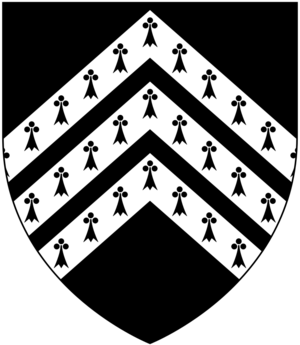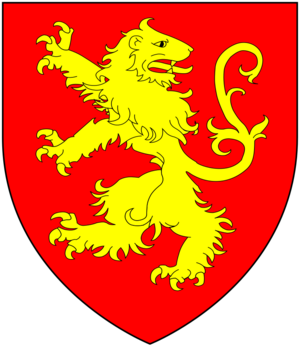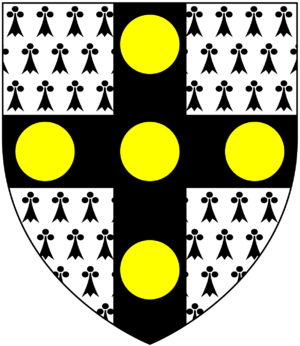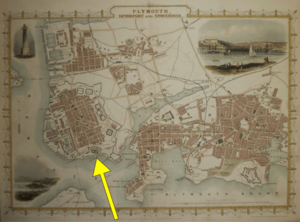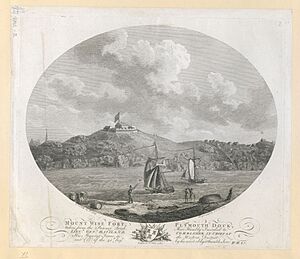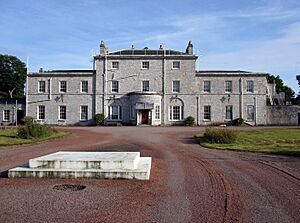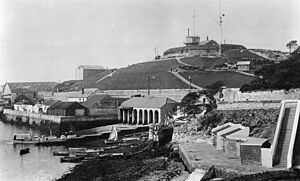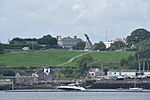Mount Wise, Plymouth facts for kids
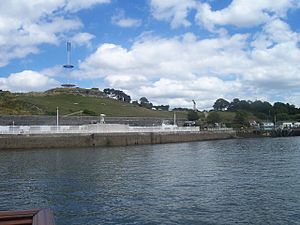
Mount Wise is a special historic area in Devonport, about a mile west of Plymouth, Devon. It has an amazing location right on the waterfront, with fantastic views across Plymouth Sound towards Mount Edgcumbe and the English Channel. For a long time, until 2004, Mount Wise was a secret headquarters for important Navy leaders and wasn't open to the public.
Contents
Early History of Mount Wise
Before the Royal Dockyard was built in 1690, the only important building in this area was a large house called Mount Wise. This house was part of a big estate known as a "manor," which was like a large piece of land owned by a powerful family.
The Wise Family
Around the year 1400, the Mount Wise area became part of the manor of Stoke Damerel. This happened when Thomas Wise married Margaret Brett. She was the daughter of Robert Brett, who owned the manor of Stoke Damerel.
The main house, known as Mount Wise, was built by Sir Thomas Wise (who lived from about 1576 to 1630). He was a very important person, serving as the Sheriff of Devon in 1612 and later as a Member of Parliament. He also made his main home, Sydenham House, much grander.
A historian from that time, Sir William Pole, wrote about Sir Thomas Wise and Mount Wise. He said that Sir Thomas built a "newe howse for his pleasure" on a high piece of land and called it Mount Wise. Sir Thomas's son, Thomas Wise (who lived from about 1605 to 1641), then lived there. He married Lady Mary Chichester. The name "Mount Wise" was a popular choice for estates in Devon, similar to other places like Mount Edgcumbe and Mount Batten.
Later, in 1667, Edward Wise (1632-1675), who was the grandson of the first Sir Thomas Wise, sold the manor of Stoke Damerel, including Mount Wise, for £11,600 to Sir William Morice.
The Morice Family
Sir William Morice (1602-1676) was a very important government official. He was the Secretary of State for the Northern Department and a Lord of the Treasury from 1660 to 1668. After him, the Stoke Damerel and Mount Wise estates passed down through his family for several generations.
Eventually, the estates were inherited by Sir John St Aubyn, 4th Baronet (1726–1772). This happened because his mother, Catherine Morice, was the sister of the last Morice owner, Sir William Morice, 3rd Baronet, who had no children.
The St Aubyn Family
Sir John St Aubyn, 4th Baronet (1726–1772) took over the estate. His son, Sir John St Aubyn, 5th Baronet (1758–1839), owned Mount Wise in 1810. At that time, the value of this property had grown a lot! The number of people living in the area had also increased hugely, from 3,361 in 1733 to 23,747 in 1800.
Sir John St Aubyn still owned the town of "Plymouth Dock" (which is now Devonport). However, he had already sold the land for the Royal Dockyard and the military defenses around the town to the government. These defenses included the area of Mount Wise.
Mount Wise as a Military Base
By the mid-1700s, strong defensive walls were built around the Royal Dockyard. Many soldiers were needed to guard these defenses, so barracks (buildings for soldiers) were built around the area in the late 1750s and early 1760s.
While the Devonport Lines protected the Dockyard from attacks by land, Mount Wise was the perfect spot to defend against attacks from the sea. In the 1770s, an octagonal (eight-sided) stone fort called a redoubt was built on Mount Wise. This fort was designed to hold cannons to protect the Royal Dockyard.
In 1806, a special signaling station was built inside the fort. This was part of a chain of 32 stations that sent messages all the way from Plymouth to the Admiralty (the Navy's headquarters) in London.
In the 1960s, much of the fort was taken down, but many parts still remain. You can still see the outer walls, metal tracks for the cannons, rings for anchoring World War II barrage balloons, and places where ammunition was stored. In 1998, a 40-meter (131-foot) tall mast was built there. It has a circular viewing platform where visitors can enjoy amazing views, especially towards the Royal William Yard.
In the late 1700s, when people were worried about a French invasion after the French Revolution (1789), a large house was built on Mount Wise. This house was for the military Governor of Plymouth. It had a big parade ground in front and a large garden stretching towards the sea.
In 1804, a branch of the Royal Laboratory was set up at Mount Wise. This laboratory made and repaired ammunition for small guns. Between 1806 and 1814, during the Napoleonic Wars, about 70 million cartridges were made here! Hundreds of men and boys worked at the laboratory. After the wars ended, the laboratory closed in 1828. The buildings were then turned into barracks for soldiers and were used by the military for many years.
Around 1810, the British Navy bought the Mount Wise estate and the Royal Dockyard from Sir John St Aubyn, 5th Baronet. They bought it because its location was so important for defending the country. Mount Wise then became the Royal Navy's main headquarters for the area.
For about 200 years, the Navy used Mount Wise. But in 2004, they left the site. In 2006, the land was sold for £5.5 million.
Mount Wise Today: A New Village
In 2011, the Mount Wise estate, which is about 28 acres of land, began a big new project. It was planned to become "The Village by the Sea," a new neighborhood with 469 new homes. The historic Admiralty House was planned to become a hotel, and there would be offices, a shop, and a restored cricket pitch. Even the old nuclear bunker was planned to become a huge data storage center!
The people planning the project wanted to create a "waterside village" with new buildings that looked like old Georgian houses, keeping Admiralty House as the main feature. The first part of the project finished in 2012. However, selling the new homes was slow because of the worldwide economic problems from 2008.
The second part of the development was supposed to be finished in September 2015. Mount Wise House has now been turned into offices, not a hotel as originally planned.


